|
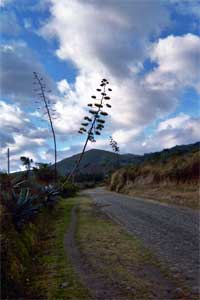
La Chimba
La Chimba is a town of around 360 families located in a fertile valley, a one hour, 60 cent bus ride northeast of the city of Cayambe, within the canton of Cayambe. The valley that contains the city is situated at the northeast end of the basin that contains Quito, the capital of Ecuador. Named after Ecuador’s nearby third highest mountain, the canton contains three urban parroquias and five rural ones. La Chimba is in the parroquia of Olmedo, which was formerly known as Pesillo. The area’s cultural history is as rich as its beautiful Andean environment. 1500 years ago, in the times before the Inka invasion, the area that is now the province of Imbabura and the northern part of the province of Pichincha was settled by the Karanki and Kayambi peoples. The social organization of these peoples did not feature a central leader. Rather, from the Guayallamba river in the south to the Chota and Mira rivers in the north, the Karanki and Kayambi peoples occupied the land as a loose federation of disparate people, even fighting amongst themselves at times. Pacha Mama, or mother earth, was part of their ethnic identity, and they were an agricultural people. They cultivated corn, quinoa, potatoes, yucca, beans, cuyes (guinea pigs), and llamas.
These indigenous peoples lived in this manner until outside invaders forced them into unity. Under Inka Huayna Capac, the Inkas finally reached the area around 1498. Under this threat, the indigenous leader Nasacota Puento emerged to consolidate the scattered people and resist the Inka occupation. Unlike so many other groups of people, the Karanki and Kayambi people did not admit defeat quickly. In fact, they were so fierce that at first the Inkas tried to use gifts to pacify them. They managed to keep the Inkas at bay for 17 years before being defeated in 1515. Upon defeating the Karankis and Kayambis, Huayna Capac killed 20,000 warriors and threw their bodies in a lake north of Ibarra, which is now called Yawar Cocha, or Lake of Blood. Then, he married an indigenous woman, Quilago Túpac Palla, and as a result of this union the last Inka leader, Atahualpa, was born.
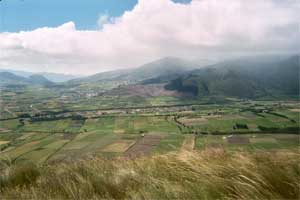 Although the Inkas only occupied the area for around twenty years, they did have a significant impact. They moved as many as 30,000 mitmaes, or colonists, in to teach the local people about the customs, religion, and political system of the Inkas. They also moved most of the indigenous people to the center of the empire, leaving only the very young and very old in Cayambe. However, the pre-Inka influence persevered and is evident in the words such as surnames ending with –ango, as in Dolores Cacuango, place names ending in –pi, as in El Chaupi, and the word for mountain (buru, as in Imbaburu). Additionally, the people in Kayambi continued speaking their native language throughout the colonial period, until it began to be displaced by priests using pan-Andean Kichwa in an attempt to solidify their teachings in the Andean region. Although the Inkas only occupied the area for around twenty years, they did have a significant impact. They moved as many as 30,000 mitmaes, or colonists, in to teach the local people about the customs, religion, and political system of the Inkas. They also moved most of the indigenous people to the center of the empire, leaving only the very young and very old in Cayambe. However, the pre-Inka influence persevered and is evident in the words such as surnames ending with –ango, as in Dolores Cacuango, place names ending in –pi, as in El Chaupi, and the word for mountain (buru, as in Imbaburu). Additionally, the people in Kayambi continued speaking their native language throughout the colonial period, until it began to be displaced by priests using pan-Andean Kichwa in an attempt to solidify their teachings in the Andean region.
The Inka attempt to assimilate the Karanki and Kayambi peoples was cut short with the arrival of the Spanish in the area in July of 1534. The Spanish conquest introduced many new things into the area, such as wheat, barley, horses, pigs, and sheep, as well as the Catholic religion. However, the indigenous people resisted this second invasion, as they had the first, and the Catholicism they practiced became syncretized with their traditional beliefs. For example, the festival of the sun that was practiced on the June solstice, called Inti Raymi, continued to be practiced under the name of the Saint Peter’s day festival. Today, Saint Peter is the patron Saint of Cayambe. In addition to passive forms of resistance such as these, the indigenous people staged many active and sometimes violent forms of protest as well. For example, in 1791 they rebelled against a mita labor draft in which the government wished to construct a bridge next to the Lita river. Also, they rebelled against the 1777 census on November 14th and 15th which would have raised tribute payments. In this protest, they burned obrajes (textile mills), and attacked haciendas and the church in Cayambe, killing three white men before the government forces arrived. Nonetheless, the indigenous person remained oppressed throughout colonial times and well into the republican period, an oppression that only now is beginning to be remedied through the hard work of indigenous groups in the area. An early example of these groups is the local syndicate Pan y Tierra from Olmedo, which was founded in 1930. Ecuador’s first national indigenous political organization, the FEI (Federación Ecuatoriana de Indios), was founded in part by people living in La Chimba in 1944. Today, La Chimba is part of the larger indigenous movement in Ecuador, in conjunction with other indigenous groups in a manner which we will examine in more detail later.
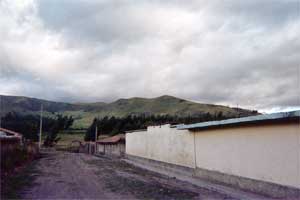 Today, one of the most important aspects of cultural preservation in La Chimba is the Kichwa language. The word Kichwa can be understood in different ways. Ethnically, Kichwa is the name of one of the twelve indigenous nationalities of which Ecuador is comprised, and includes roughly 147,000 people. Linguistically, Kichwa is a dialect of the Quechua language. Quechua (Runa Simi), is divided into two distinct branches. Quechua I (Waywash) is the most archaic and is spoken in the Peruvian highlands. Quechua II (Wanp’una) is further subdivided into three dialects: Yunkay Quechua, Southern Quechua, and Northern Quechua (Kichwa or Runashimi). Today, one of the most important aspects of cultural preservation in La Chimba is the Kichwa language. The word Kichwa can be understood in different ways. Ethnically, Kichwa is the name of one of the twelve indigenous nationalities of which Ecuador is comprised, and includes roughly 147,000 people. Linguistically, Kichwa is a dialect of the Quechua language. Quechua (Runa Simi), is divided into two distinct branches. Quechua I (Waywash) is the most archaic and is spoken in the Peruvian highlands. Quechua II (Wanp’una) is further subdivided into three dialects: Yunkay Quechua, Southern Quechua, and Northern Quechua (Kichwa or Runashimi).
Although located in a broader Kichwa ethno-linguistic group, the Kayambi people are unique in their own fashion. They have not only historically, but continue to this day, to defend their culture, religion, and customs. They have even created their own unique musical rhythm, called Xuan. Through syncretism, the rhythm became known first as Juan and then as San Juan or San Juanito. However, this rhythm is universally understood to be the property of the people of Cayambe. An example of a type of music that uses this rhythm is Abuchicho, music that can be found throughout fiestas in the area and is usually accompanied by men wearing Samados (alpaca wool pants) and other traditional dress.
During the colonial and republican periods, the people of La Chimba were oppressed in a fashion similar to that of all indigenous people in the country under the Huasipungo system. Under this system, the indigenous people of Ecuador were effectively enslaved through debt peonage, tying them to the hacienda for life working four days a week in exchange for a small plot of land (minifundio). There was rarely any form of education for indigenous children until the middle of the twentieth century. For reasons such as these, people like Tránsito Amaguaña began to fight for the rights of the indigenous workers on the haciendas.
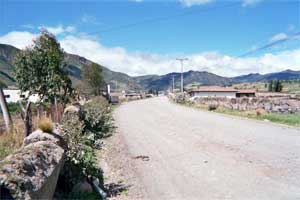 “Mama Tránsito,” as she is now lovingly known, is from nearby Pesillo, but is now a resident of La Chimba. Her life not only coincides with a period of great change in La Chimba, but deserves a great deal of credit for it as well. She was born in 1909, and 22 years later, in 1931, she was present at Ecuador’s first example of a fight for the rights of agricultural workers at the Olmedo hacienda, a thirty minute walk from La Chimba. Through the work of Tránsito and others like her, hacienda lands were broken up into cooperatives, where the indigenous people worked the land for the government. Under this land tenure pattern, land was taken from the hacendados, and administered by government employees that maintained the previous forms of agricultural activity. The workers effectively continued working in the same manner as before, but under better conditions and for greater pay. Although these pay increases were small, this was one step closer to the agrarian freedom of the indigenous peoples of Ecuador. In 1944, Trànsito founded the FEI with fellow activists Dolores Cacuango and Jesus Gualavisi. One year later, this organization was responsible for the founding of multiple bilingual schools, four of which were in the area of La Chimba. She also requested tractors from the government for the people to use instead of oxen. “Mama Tránsito,” as she is now lovingly known, is from nearby Pesillo, but is now a resident of La Chimba. Her life not only coincides with a period of great change in La Chimba, but deserves a great deal of credit for it as well. She was born in 1909, and 22 years later, in 1931, she was present at Ecuador’s first example of a fight for the rights of agricultural workers at the Olmedo hacienda, a thirty minute walk from La Chimba. Through the work of Tránsito and others like her, hacienda lands were broken up into cooperatives, where the indigenous people worked the land for the government. Under this land tenure pattern, land was taken from the hacendados, and administered by government employees that maintained the previous forms of agricultural activity. The workers effectively continued working in the same manner as before, but under better conditions and for greater pay. Although these pay increases were small, this was one step closer to the agrarian freedom of the indigenous peoples of Ecuador. In 1944, Trànsito founded the FEI with fellow activists Dolores Cacuango and Jesus Gualavisi. One year later, this organization was responsible for the founding of multiple bilingual schools, four of which were in the area of La Chimba. She also requested tractors from the government for the people to use instead of oxen.
On August 11th, 1971, La Chimba was transformed from a cooperative into a community. Under this arrangement the cooperative lands, owned by the government, were broken up and distributed to the people. Each family received six hectares of land, which they could farm, sell, or buy as they wished. In general, La Chimba has not practiced primogeniture, in which all of a family’s land is inherited by the eldest son. As a result, landholdings have been divided into parcels smaller than the original six hectares.
Partially as a result of the transformation from cooperative to community, the 1980s were a time of changes to the lifestyle of people living in La Chimba. Before this time, cooking was done in a llanda, or indoor fireplace, and the people lit their houses at night with oil lamps. However, this time period saw the installation of electricity and the introduction of stoves with portable gas tanks. It was also during this time that the people of La Chimba built a water purification plant through community minga, eliminating the use of river water for drinking. Therefore, the transformation from cooperative to community, while an advance in itself, was also beneficial in that it afforded the people of La Chimba the opportunity to improve their lives in the ways mentioned above. They would have been far less likely to make these improvements had they not owned the land themselves.
La Chimba is a beautiful town. Located in a high valley, surrounded by mountains, the view in every direction is that of rustic Andean scenery. The Golondrinas hot springs, administered by La Chimba, can be reached by a twenty minute car ride followed by thirty minutes of walking in the countryside. The springs, located in a crevice between two mountains, give a breathtaking view of the valley below. Not far past the springs is the huge Cayambe-Coca Ecological Reserve. The preserve offers a large freshwater lagoon, diverse wildlife, and a view of the mountains that mark the border between the Sierra and the rainforest. Within the town itself, is the ancient Petroglifo La Chimba, dating 730 years before Christ, and the old hacienda which, now under renovation, gives us a glimpse of Ecuador’s history.
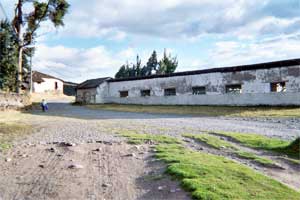 The hacienda also houses the Acopio, which is the economic center of La Chimba. Every day, 175 families bring milk to the Acopio, the modern dairy warehouse. The Acopio brings in an average of 9000 liters of milk per day. The families receive 26 cents per liter, and the company in turn sells the milk in the Cayambe market. Although now dairy farming comprises the main economic activity of the town, efforts are underway to increase crop growth in order to form a surplus to sell in the Cayambe market and thus augment the community’s economic growth. The hacienda also houses the Acopio, which is the economic center of La Chimba. Every day, 175 families bring milk to the Acopio, the modern dairy warehouse. The Acopio brings in an average of 9000 liters of milk per day. The families receive 26 cents per liter, and the company in turn sells the milk in the Cayambe market. Although now dairy farming comprises the main economic activity of the town, efforts are underway to increase crop growth in order to form a surplus to sell in the Cayambe market and thus augment the community’s economic growth.
One way in which La Chimba maintains its unique identity is through its traditional style of clothing, which is different from even its nearby neighbors Olmedo and Pesillo. At any fiesta in La Chimba, you are sure to see the men dressed in samado. The colorful shirt worn by the women is called a pañalon. Their bright, gold-colored necklaces are made from the metal hualka. Also unique are the women’s slipper-type shoes, called apargates, and the makiwatana bracelets made of tiny beads. For good examples of this traditional clothing, as well as the Abuchicho San Juan rhythm, see the music video for the song “Con mi Guitarra,” by Rosita Quilo, filmed in Cayambe.
Today, La Chimba is a town that is on the forefront of the indigenous movement in Ecuador. Unlike nearby Olmedo and Pesillo, La Chimba has resisted the process of mestizaje. The population of La Chimba is 100% indigenous Kayambi, and the majority of its residents were born in the town as well. As the indigenous identity became manifest in Ecuadorian culture, various local groups formed that were often of an indigenous nature. This sense of autonomy spurred the formation of groups of a different nature, and the reality of the intersection of multiple identities within a person is evidenced in those groups that we see today in La Chimba. The Community of La Chimba is comprised of five groups: the Acopio, the children’s soccer league, Condor Huasi, and two women’s groups, named Tránsito Amaguaña and Dolores Cacuango. When the community of La Chimba is dissected, we see various interests represented: children’s, women’s, indigenous peoples’, and economic. La Chimba interacts with ten other communities through COINO (Indigenous Communities of Olmedo), which in turn works with the group Pueblo Kayambi. Pueblo Kayambi is part of the Andean league ECUARUNARI, which is one of the three groups that form CONAIE. CONAIE has been responsible for the advancement of indigenous rights for decades, staging huge strikes and protests, fielding political candidates, and increasing the solidarity of Ecuador’s indigenous peoples. Through these means, CONAIE has seen many of its demands met, and through CONAIE, the people of La Chimba and other communities throughout Ecuador are able to have their indigenous and other interests considered.
These groups, especially Condor Huasi (House of the Condor) and the two women’s groups, have made significant progress in increasing historical and cultural awareness in the community. According to Clemencia, 58, the children today are learning more about their culture than children did during her childhood. To continue in this path, she feels that remembering and preserving the Kichwa language and traditional clothing of the community are of the utmost importance. Furthermore, as the mothers and the keepers of collective knowledge, she says the women are the ones with whom this responsibility lies. Just as Pacha Mama is the source of life and nourishment, the indigenous woman is the source of the indigenous identity. Clemencia’s view is shared by Doris Bill of the Kuna people of Panama. She says that woman is “the basis of life as the donor, strategist, visionary, motivator, and transmitter of cultural identity.”
The name La Chimba is from the Kichwa yacuchimba, or “braided river”. It is so named to allude to the winding together of the various rivers and streams in the area to form a water system; the Izmuquiro, Sapopampa, Golondrinas, Jatun Turo, Charpar, and La Chimba rivers. Today, we may see La Chimba as braided of more than just water. It is a braiding together of the old with the new: Kichwa with Spanish, traditions with technology, indigenous legends with modern education. The resulting community is one comprised of people who are ready to enter into Ecuador as a functioning economic and cultural part, while retaining their identity and sense of cultural autonomy, living as they have for centuries.
|
